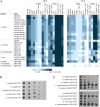Genotypic and phenotypic diversity among Komagataella species reveals a hidden pathway for xylose utilization
- PMID: 35468837
- PMCID: PMC9036795
- DOI: 10.1186/s12934-022-01796-3
Genotypic and phenotypic diversity among Komagataella species reveals a hidden pathway for xylose utilization
Abstract
Background: The yeast genus Komagataella currently consists of seven methylotrophic species isolated from tree environments. Well-characterized strains of K. phaffii and K. pastoris are important hosts for biotechnological applications, but the potential of other species from the genus remains largely unexplored. In this study, we characterized 25 natural isolates from all seven described Komagataella species to identify interesting traits and provide a comprehensive overview of the genotypic and phenotypic diversity available within this genus.
Results: Growth tests on different carbon sources and in the presence of stressors at two different temperatures allowed us to identify strains with differences in tolerance to high pH, high temperature, and growth on xylose. As Komagataella species are generally not considered xylose-utilizing yeasts, xylose assimilation was characterized in detail. Growth assays, enzyme activity measurements and 13C labeling confirmed the ability of K. phaffii to utilize D-xylose via the oxidoreductase pathway. In addition, we performed long-read whole-genome sequencing to generate genome assemblies of all Komagataella species type strains and additional K. phaffii and K. pastoris isolates for comparative analysis. All sequenced genomes have a similar size and share 83-99% average sequence identity. Genome structure analysis showed that K. pastoris and K. ulmi share the same rearrangements in difference to K. phaffii, while the genome structure of K. kurtzmanii is similar to K. phaffii. The genomes of the other, more distant species showed a larger number of structural differences. Moreover, we used the newly assembled genomes to identify putative orthologs of important xylose-related genes in the different Komagataella species.
Conclusions: By characterizing the phenotypes of 25 natural Komagataella isolates, we could identify strains with improved growth on different relevant carbon sources and stress conditions. Our data on the phenotypic and genotypic diversity will provide the basis for the use of so-far neglected Komagataella strains with interesting characteristics and the elucidation of the genetic determinants of improved growth and stress tolerance for targeted strain improvement.
Keywords: Genome sequencing; Komagataella species; Pichia pastoris; Xylose assimilation; Yeast diversity.
© 2022. The Author(s).
Conflict of interest statement
The authors declare that they have no competing interests.
Figures







References
Publication types
MeSH terms
Substances
Grants and funding
LinkOut - more resources
Full Text Sources
Research Materials

